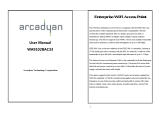
1
Contents
Introduction ...............................................................................................................3
AP-7522 Access Point Overview .................................................................................................................................3
Document Conventions ..................................................................................................................................................3
Warnings ...............................................................................................................................................................................3
Site Preparation ................................................................................................................................................................ 4
AP-7522 Package Contents ......................................................................................................................................... 4
Features ........................................................................................................................................................................................... 4
AP-7522 Antennas ........................................................................................................................................................... 4
AP-7522 Dual Band 2.4 GHz / 5 GHz Antennas - US ....................................................................................................4
AP-7522 Dual Band 2.4 GHz / 5 GHz Antennas - EMEA .............................................................................................. 5
AP-7522 Internal Antenna Model .......................................................................................................................................... 6
AP-7522 Dual Band 2.4 GHz / 5 GHz Antennas - Canada ..........................................................................................6
Hardware Installation ...............................................................................................7
Installation Instructions ...................................................................................................................................................7
Precautions ..........................................................................................................................................................................7
Access Point Placement ................................................................................................................................................ 8
Power Injector System ................................................................................................................................................... 8
Wall Mount Instructions ................................................................................................................................................10
Wall Mount Procedure - New Installation ........................................................................................................................ 10
Wall Mount Procedure - Existing Access Point Replacement ..................................................................................12
Suspended Ceiling T-Bar Mount Installation ........................................................................................................ 12
LED Indicators ...................................................................................................................................................................16
Basic Access Point Configuration......................................................................... 19
AP-7522 Access Point Specifications ..................................................................27
Electrical Characteristics ............................................................................................................................................. 27
Physical Characteristics ............................................................................................................................................... 27
Radio Characteristics ....................................................................................................................................................28
................................................................................................................................................................................................28
Regulatory Information......................................................................................... 29
Regulatory Information ................................................................................................................................................29
Wireless Device Country Approvals .......................................................................................................................29
Country Selection ..................................................................................................................................................................... 30
Frequency of Operation – FCC and IC ............................................................................................................................. 30
Health and Safety Recommendations ...................................................................................................................30
Warnings for the use of Wireless Devices .......................................................................................................................32
Potentially Hazardous Atmospheres – Fixed Installations .......................................................................................32
Safety in Hospitals .....................................................................................................................................................................32
RF Exposure Guidelines ............................................................................................................................................... 32
Safety Information .....................................................................................................................................................................32
Reducing RF Exposure - Use Properly ........................................................................................................................................... 32
International .................................................................................................................................................................................32




















